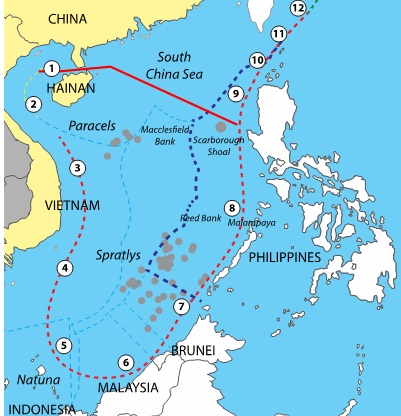By ELLEN T. TORDESILLAS
 CHINA’s 9-dashed line map, which was recently expanded to 10 dashes, goes against the “concept of global commons” which was the foundation of the 1982 United Nations Convention of the Law of the Sea, Senior Associate Justice Antonio Carpio said in a speech delivered on the 75th Anniversary of the College of Law of the University of San Agustin in Iloilo City last Aug. 30.
CHINA’s 9-dashed line map, which was recently expanded to 10 dashes, goes against the “concept of global commons” which was the foundation of the 1982 United Nations Convention of the Law of the Sea, Senior Associate Justice Antonio Carpio said in a speech delivered on the 75th Anniversary of the College of Law of the University of San Agustin in Iloilo City last Aug. 30.
Thus,Carpio said, China fisheries laws particularly giving Hainan, China southernmost province, exclusive jurisdiction over the waters in the South China Sea as well as on the fishery resources of Macclesfield Bank is “a grand theft of the global commons in the South China Sea.”
Carpio traced the origin of the concept of the global commons way back in the 6th century when The Institutes of Justinian of the Roman Emperor Justinian, declared that the sea is “common to mankind” and its use is subject only to “the law of nations.”
Carpio said the Dutchman Hugo Grotius wrote his famous Mare Liberum or the Free Sea in 1609 that “No nation could claim ownership of the oceans and seas because they belonged to all mankind.”
The naval powers at that time – Spain, Portugal and England – held the opposite view, claiming ownership of the oceans and seas by discovery, he further related.
An opposite view was forwarded by the Englishman John Selden. But Carpio said, “Grotius’ idea eventually won and became the foundation of the law of the sea” earning for the Dutchman the stature as “ Father of international law.”
“Thus, under international law since the turn of the 19th century until today, the waters beyond a coastal State’s territorial sea could never be subject to sovereignty by the coastal State. Before UNCLOS, the territorial sea was a belt of 3-NMs of waters from the coast, and beyond this 3-NM territorial sea was the high seas, belonging to all mankind as part of the global commons. Under international law, before and after UNCLOS, no State could appropriate the high seas as its own exclusive waters. Before and after UNCLOS, the high seas were part of the global commons,” Carpio said.
Here comes China’s 1986 Fisheries Law which was amended in 2011 that requires foreign fishing vessels to secure permission from Chinese authorities “before entering the territorial waters of the People’s Republic of China to carry on fishery production or investigation of fishery resources.”

Carpio sounded the alarm:” The problem arises when China’s Fisheries Law is applied to the high seas, and to the EEZs of other coastal States, that China claims fall within its 9-dashed lines in the South China Sea. China’s 12th Five-Year Plan for National Oceanic Development states that the sea area under China’s jurisdiction comprises three million square kilometers. The 12th Five-Year Plan of the Hainan Maritime Safety Administration states that the sea area under Hainan’s jurisdiction comprises two million square kilometers. The South China Sea has a sea area of three million five hundred thousand square kilometers. In the 1988 decision of China’s National People’s Congress creating the province of Hainan, Hainan’s territory expressly includes Zhongsa Island or what is internationally known as Macclesfield Bank. “
Carpio stressed the importance Macclesfield Bank:
“Macclesfield Bank is one of the largest atolls in the world, with a water surface area of 6,448 square kilometers, about ten times the land area of Metro Manila. Macclesfield Bank lies just outside the Philippines’ EEZ facing the South China Sea in Luzon Island. Macclesfield Bank is named after the HMS Macclesfield, a British warship that ran aground in the area in 1804.
“Macclesfield Bank is not an island but a fully submerged atoll whose highest peak is some 9 meters below sea level. China calls Macclesfield Bank the Zhongsa Island, which is glaringly misleading because the entire area is fully submerged even at high tide. Under UNCLOS, a geologic feature is an island only if it is above water at high tide. Macclesfield Bank does not qualify as an island under this UNCLOS definition. An island is subject to a claim of territorial sovereignty but not a fully submerged atoll beyond the territorial sea like Macclesfield Bank. As a fully submerged atoll beyond China’s territorial sea, Macclesfield Bank is not subject to any claim of territorial sovereignty by China. And since Macclesfield Bank is beyond China’s EEZ, China cannot also claim any sovereign right to exploit exclusively the fishery resources in Macclesfield Bank.
“Under UNCLOS, Macclesfield Bank is part of the high seas since it is situated beyond the EEZ of any coastal state. Macclesfield Bank is within the hole of the doughnut in the middle of the South China Sea. UNCLOS prohibits any State from subjecting the high seas to its sovereignty. All States have the right to fish in Macclesfield Bank, which is part of the global commons. Macclesfield Bank, rich in fishery resources, has been a traditional fishing ground of Filipino fishermen, just like the nearby Scarborough Shoal. “
The Philippines has questioned before UNCLOS’ tribunal China’s 9-dashed line map which encroaches on 80% of the EEZ of the Philippines in the West Philippine Sea, including the Reed Bank and the Malampaya gas field.
“The stakes are enormous not only for the Philippines, but also for all States of this planet,” Carpio said.
He said the Philippine suit before UNCLOS is to prevent China from encroaching not only on the EEZ of the Philippines, but also on the global commons in the South China Sea.
“The Philippines is fighting a legal battle not only for itself but also for all mankind. A victory for the Philippines is a victory for all States, coastal and landlocked, that China has shut out of the global commons in the South China Sea. ASEAN States whose EEZs are also encroached by China’s 9-dashed lines will likewise benefit immensely from a Philippine victory,” Carpio said.
A cartographic exhibit “Historical Truths and Lies ( Scarborough Shoal in Ancient Maps) will be launched on Thursday, Sept. 11 at De La Salle University on Taft Avenue (6th floor Henry Sy Hall).
The exhibit, based on the impressive June 6, 2014 lecture of Senior Associate Justice Antonio T. Carpio on Sept. 11, 2 p.m., is presented by the Institute for Maritime and Ocean Affairs; Maritime Law Association of the Philippines and DLSU.





